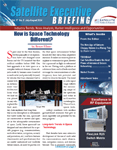Satellite Operator Financials Facing Significant HTS Impact
Cambridge, MA, October 1, 2015--NSR’s Satellite Operator Financial Analysis (SOFA), 5th Edition, published today, finds that as GEO-HTS payloads continue to become more prevalent, satellite operator business models are encountering dramatic effects, including altered CAPEX cycles, lower backlogs, and falling revenues per transponder.
“GEO-HTS payloads have had a dramatic impact on CAPEX cycles of satellite operators. We now see operators being able to minimize CAPEX by investing in one big GEO-HTS payload rather than 2-3 FSS satellites, and still end up with more capacity, which in a vacuum is a good thing”, states Blaine Curcio, Senior Analyst and report author. “What we’ve not yet seen is the end result—do our traditional FSS satellites with transponder counts in the dozens just become obsolete? Or is there still value in having 30 traditional transponders on a satellite, a few orbital slots away from one that has 300? These questions become important when even the 30 transponder satellite is, on paper, a $250M asset”, adds Curcio.
The above scenario becomes especially appealing when operators have significant debt loads—i.e. Intelsat or Telesat—or when the operator has few traditional in-orbit assets to lose—i.e. a new market entrant such as YahSat or Avanti. “We are starting to see the impact that GEO-HTS payloads can have on revenues. Thaicom sees over $100M per year from IPSTAR. YahSat’s revenues per operational satellite metric exceeds $100M, and Avanti sees >$40M revenues per satellite at a self-admitted 20-25% fill rate. These are huge numbers compared to anything that a traditional FSS satellite could come to expect, and this is still only the beginning”, says Curcio.
Beyond this, 2014 saw the Big Four’s overall revenue decline by over $200M in U.S. Dollar terms, with Intelsat leading the charge with significant revenue woes, and a strong dollar weakening decent revenue growth at SES and Eutelsat. Regional players performed better overall, with some outliers losing significantly due to currency exchange rates, but most faring quite well. Growth continues to come from GEO-HTS payloads, though whether a dramatic drop in pricing will really expand the total addressable market remains up for debate. MSS operators covered in this study, as well as a number of FSS operators, will need to rely on niche value-adds such as connectivity anywhere or high throughput per beam, but how long this will remain a justification for higher bandwidth costs is unclear.
NSR’s Satellite Operator Financial Analysis, 5th Edition, provides industry-leading analysis and comprehensive research on all aspects relating to the financial side of the FSS and MSS sectors. With financial data taken from 8 fully-reporting operators, 8 partially-reporting operators, and 11 other operators from which data was derived from industry-recognized sources, SOFA5 is unparalleled in its level of detail and scope of data, supplemented by unique NSR analysis and insights. With over 200 tables and charts, and data from 2008 to H1 2015, SOFA5 is the definitive tool for understanding the answers to strategic questions surrounding the financial side of the FSS and MSS sectors. Satellite Operator Financial Analysis (SOFA), 5th Edition, is a multi-client report now available from NSR.
For additional information on this report, including a full table of contents, list of exhibits and executive summary, please visit www.nsr.com or call NSR at +1-617-674-7743.






